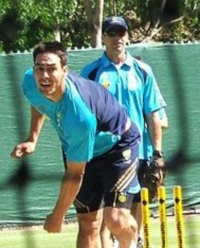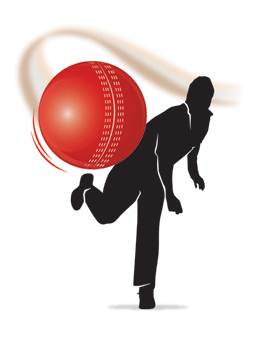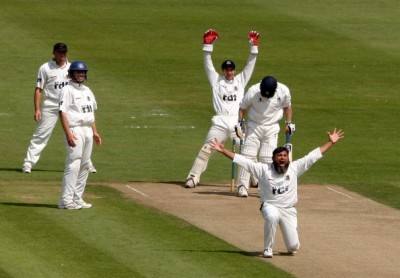"You'll be a Lesser Coach if You Don't Have Technology", Toby Radford Reveals
 There's no doubt that technology is transforming the way we prepare as cricketers. Analysis tools have never been easier or cheaper so even club players can get in on the game.
There's no doubt that technology is transforming the way we prepare as cricketers. Analysis tools have never been easier or cheaper so even club players can get in on the game.
When I interviewed Glamorgan Coach Toby Radford, I asked him about how he uses technology to help him coach, and his answer was emphatic:
How to Bowl Like Mitchell Johnson
 This is a guest article from former professional bowler, and current Strength, Conditioning and Fast Bowling Coach Steffan Jones.
This is a guest article from former professional bowler, and current Strength, Conditioning and Fast Bowling Coach Steffan Jones.
Why is Mitchell Johnson so unplayable at the moment?
What has made him change from a guy that struggled to hit the cut strip to now being the quickest bowler in the world and a genuine game changer?
Use This Simple 3 Stage Drill to Improve Batting Decision Making

Last week I talked about the missing two thirds of batting and focused on helping batters pick up visual cues. The next phase of the batting process is to build up our decision making capacity.
One of the ways that works for me is to build up the number of resources available to the individual: That is to say which options can be used.
I then to test which ones are most effective in a variety of scenarios and match conditions. This way, the player starts to decide for themselves.
I ran a session based on this today around playing spin using the Merlyn spin bowling machine variation mode which subtly shifts lengths by 10% either way.
The session went a little bit like this:
Streetwise Bowling: The Preseason Bounce Pounce
 This article is part of the "Streetwise Bowling" series from PitchVision Academy. To view the full list of tactics click here.
This article is part of the "Streetwise Bowling" series from PitchVision Academy. To view the full list of tactics click here.
I'll be honest with you about this one, it's disgustingly simple. So much so you might shrug and go "so what?". Yet year after year I see young fast bowlers make this mistake in the early season and miss out on a bundle of wickets as more canny seamers take full advantage.
So, this edition of "Streetwise Bowling" is more of a story than a set of balls.
Streetwise Bowling: The Seamer's Subtlety
 This article is part of the "Streetwise Bowling" series from PitchVision Academy. To view the full list of tactics click here.
This article is part of the "Streetwise Bowling" series from PitchVision Academy. To view the full list of tactics click here.
As a seamer, you lack the subtle variety of seam and swing. You are probably not that quick. You are McGrath, relentlessly hitting your length and relying on the seam for variety.
But even the metronome needs something else.
Batsmen get well set on a flat pitch. You come up against a player who you know is a little sluggish to get forward early in his innings. The ball gets old and worn at the end of an innings.
It's time to take a wicket through subtlety.
Streetwise Bowling: The Warne Rounder
 This article is part of the "Streetwise Bowling" series from PitchVision Academy. To view the full list of tactics click here.
This article is part of the "Streetwise Bowling" series from PitchVision Academy. To view the full list of tactics click here.
Bowling accurate leg spin is hard enough, but to bowl a whole over accurately and also to a plan is the skill of a master craftsman. Someone like Shane Warne.
Streetwise Bowling: Your Guide to Planning the Destruction of Batsmen
 Every bowler needs a plan.
Every bowler needs a plan.
For most, especially the inexperienced, it doesn't get more complicated than "hit the top of off stump". Of course, there is nothing wrong with that plan. It often works. But batsmen are canny. They don't always do what you want.
That's why the really good bowler is able to bowl to a plan that goes beyond the basics and into the wicket-taking stratosphere.
Don't Panic: The Cricket Captain's Emergency Guide to Desperate Tactics
Is it Time to Stop Being Afraid of Bowling Around the Wicket?
 Menno Gazendam is author of Spin Bowling Project. Get your free 8 week spin bowling course here
Menno Gazendam is author of Spin Bowling Project. Get your free 8 week spin bowling course here
The last few decades spin bowlers - especially off-spinners - have been trained to bowl over the wicket. They are very rarely were told to go around the wicket.
Is Bad Planning Costing You Wickets?
 This is a guest article from Harry Shapiro, spin bowling coach. To get your free trial membership of the Leg Spin Association, click here.
This is a guest article from Harry Shapiro, spin bowling coach. To get your free trial membership of the Leg Spin Association, click here.
Planning your over is hard. It take plenty of practice and control. No wonder young spinners get despondent when it doesn't quite work. That's no excuse to abandon good planning.
Part of the reason spinners don't plan their overs well is because the state of the game brings in a lot of different ways to approach things.To make it easier, here is a basic guideline from which you can start thinking about your bowling. You may adapt it to the state of the game on the day, but start here if you want to plan well.
There are two ways to look at planning an over:


